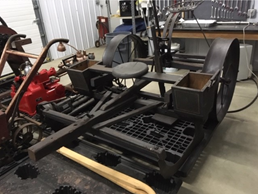
This machine is a horse-drawn check row corn planter. It has steel wheels one cast iron seat and a second wood seat, levers, and seed boxes. It was manufactured by Brown’s Horse Rotary Shop, Galesburg, Illinois. Patent dates found on this piece are Feb. 1, 1870, July 1, and 16, 1885.
Before the invention of the check row planter farmers could plant about one acre of corn per day, limiting production to ten acres per year. Check row planting allowed planting of 10 to 20 acres per day, increasing corn yields.
Check row planting is a labor-intensive method of planting. Before planting could start, the field had to be marked. Two people operated the machine; one person driving (seated on a steel seat at the rear of the planter) and the other person riding on the front seat. When the planter crossed the row marks in the field, they operated the lever that dropped seed from the seed boxes into the soil. Seeds are dropped in hills spaced 42 inches apart in each direction, creating a field with a checkerboard appearance.
Planting in this checkerboard pattern makes it possible to cultivate fields both ways and provides better weed control. Planting hills 42 inches apart accommodated the horses or mules pulling the cultivator. During cultivation, the soil is thrown up around each hill and takes out weeds. Check row planting has disadvantages. It is labor-intensive, it cannot be done on contoured land, and it takes up a lot of space, thus decreases harvest. Chemical fertilizers and herbicides, as well as technological advances, contributed to the death of check row planting.
Check row planting is rarely seen today.

